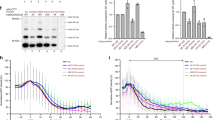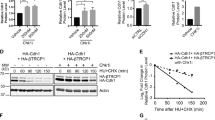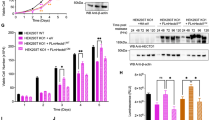Abstract
The anaphase-promoting complex/cyclosome (APC/C) is a ~1.5-MDa multiprotein E3 ligase enzyme that regulates cell division by promoting timely ubiquitin-mediated proteolysis of key cell-cycle regulatory proteins. Inhibition of human APC/CCDH1 during interphase by early mitotic inhibitor 1 (EMI1) is essential for accurate coordination of DNA synthesis and mitosis. Here, we report a hybrid structural approach involving NMR, electron microscopy and enzymology, which reveal that EMI1's 143-residue C-terminal domain inhibits multiple APC/CCDH1 functions. The intrinsically disordered D-box, linker and tail elements, together with a structured zinc-binding domain, bind distinct regions of APC/CCDH1 to synergistically both block the substrate-binding site and inhibit ubiquitin-chain elongation. The functional importance of intrinsic structural disorder is explained by enabling a small inhibitory domain to bind multiple sites to shut down various functions of a 'molecular machine' nearly 100 times its size.
This is a preview of subscription content, access via your institution
Access options
Subscribe to this journal
Receive 12 print issues and online access
$189.00 per year
only $15.75 per issue
Buy this article
- Purchase on Springer Link
- Instant access to full article PDF
Prices may be subject to local taxes which are calculated during checkout







Similar content being viewed by others
References
Deshaies, R.J. & Joazeiro, C.A. RING domain E3 ubiquitin ligases. Annu. Rev. Biochem. 78, 399–434 (2009).
Barford, D. Structural insights into anaphase-promoting complex function and mechanism. Phil. Trans. R. Soc. Lond. B 366, 3605–3624 (2011).
McLean, J.R., Chaix, D., Ohi, M.D. & Gould, K.L. State of the APC/C: organization, function, and structure. Crit. Rev. Biochem. Mol. Biol. 46, 118–136 (2011).
da Fonseca, P.C. et al. Structures of APC/C(Cdh1) with substrates identify Cdh1 and Apc10 as the D-box co-receptor. Nature 470, 274–278 (2011).
Chao, W.C., Kulkarni, K., Zhang, Z., Kong, E.H. & Barford, D. Structure of the mitotic checkpoint complex. Nature 484, 208–213 (2012).
Buschhorn, B.A. et al. Substrate binding on the APC/C occurs between the coactivator Cdh1 and the processivity factor Doc1. Nat. Struct. Mol. Biol. 18, 6–13 (2011).
Tian, W. et al. Structural analysis of human Cdc20 supports multisite degron recognition by APC/C. Proc. Natl. Acad. Sci. USA 109, 18419–18424 (2012).
Musacchio, A. Spindle assembly checkpoint: the third decade. Phil. Trans. R. Soc. Lond. B 366, 3595–3604 (2011).
Kim, S. & Yu, H. Mutual regulation between the spindle checkpoint and APC/C. Semin. Cell Dev. Biol. 22, 551–558 (2011).
Herzog, F. et al. Structure of the anaphase-promoting complex/cyclosome interacting with a mitotic checkpoint complex. Science 323, 1477–1481 (2009).
Dong, X. et al. Control of G1 in the developing Drosophila eye: rca1 regulates Cyclin A. Genes Dev. 11, 94–105 (1997).
Reimann, J.D., Gardner, B.E., Margottin-Goguet, F. & Jackson, P.K. Emi1 regulates the anaphase-promoting complex by a different mechanism than Mad2 proteins. Genes Dev. 15, 3278–3285 (2001).
Hsu, J.Y., Reimann, J.D., Sorensen, C.S., Lukas, J. & Jackson, P.K. E2F-dependent accumulation of hEmi1 regulates S phase entry by inhibiting APC(Cdh1). Nat. Cell Biol. 4, 358–366 (2002).
Margottin-Goguet, F. et al. Prophase destruction of Emi1 by the SCF(betaTrCP/Slimb) ubiquitin ligase activates the anaphase promoting complex to allow progression beyond prometaphase. Dev. Cell 4, 813–826 (2003).
Grosskortenhaus, R. & Sprenger, F. Rca1 inhibits APC-Cdh1(Fzr) and is required to prevent cyclin degradation in G2. Dev. Cell 2, 29–40 (2002).
Di Fiore, B. & Pines, J. Emi1 is needed to couple DNA replication with mitosis but does not regulate activation of the mitotic APC/C. J. Cell Biol. 177, 425–437 (2007).
Machida, Y.J. & Dutta, A. The APC/C inhibitor, Emi1, is essential for prevention of rereplication. Genes Dev. 21, 184–194 (2007).
Ban, K.H. et al. The END network couples spindle pole assembly to inhibition of the anaphase-promoting complex/cyclosome in early mitosis. Dev. Cell 13, 29–42 (2007).
Reimann, J.D. et al. Emi1 is a mitotic regulator that interacts with Cdc20 and inhibits the anaphase promoting complex. Cell 105, 645–655 (2001).
Guardavaccaro, D. et al. Control of meiotic and mitotic progression by the F box protein beta-Trcp1 in vivo. Dev. Cell 4, 799–812 (2003).
Hansen, D.V., Loktev, A.V., Ban, K.H. & Jackson, P.K. Plk1 regulates activation of the anaphase promoting complex by phosphorylating and triggering SCFbetaTrCP-dependent destruction of the APC Inhibitor Emi1. Mol. Biol. Cell 15, 5623–5634 (2004).
Miller, J.J. et al. Emi1 stably binds and inhibits the anaphase-promoting complex/cyclosome as a pseudosubstrate inhibitor. Genes Dev. 20, 2410–2420 (2006).
Ohe, M. et al. Emi2 inhibition of the anaphase-promoting complex/cyclosome absolutely requires Emi2 binding via the C-terminal RL tail. Mol. Biol. Cell 21, 905–913 (2010).
Tang, W. et al. Emi2-mediated inhibition of E2-substrate ubiquitin transfer by the anaphase-promoting complex/cyclosome through a D-box-independent mechanism. Mol. Biol. Cell 21, 2589–2597 (2010).
Dunker, A.K. et al. Intrinsically disordered protein. J. Mol. Graph. Model. 19, 26–59 (2001).
Gieffers, C., Dube, P., Harris, J.R., Stark, H. & Peters, J.M. Three-dimensional structure of the anaphase-promoting complex. Mol. Cell 7, 907–913 (2001).
Dube, P. et al. Localization of the coactivator Cdh1 and the cullin subunit Apc2 in a cryo-electron microscopy model of vertebrate APC/C. Mol. Cell 20, 867–879 (2005).
Rodrigo-Brenni, M.C. & Morgan, D.O. Sequential E2s drive polyubiquitin chain assembly on APC targets. Cell 130, 127–139 (2007).
Aristarkhov, A. et al. E2-C, a cyclin-selective ubiquitin carrier protein required for the destruction of mitotic cyclins. Proc. Natl. Acad. Sci. USA 93, 4294–4299 (1996).
Yu, H., King, R.W., Peters, J.M. & Kirschner, M.W. Identification of a novel ubiquitin-conjugating enzyme involved in mitotic cyclin degradation. Curr. Biol. 6, 455–466 (1996).
Summers, M.K., Pan, B., Mukhyala, K. & Jackson, P.K. The unique N terminus of the UbcH10 E2 enzyme controls the threshold for APC activation and enhances checkpoint regulation of the APC. Mol. Cell 31, 544–556 (2008).
Dimova, N.V. et al. APC/C-mediated multiple monoubiquitylation provides an alternative degradation signal for cyclin B1. Nat. Cell Biol. 14, 168–176 (2012).
Garnett, M.J. et al. UBE2S elongates ubiquitin chains on APC/C substrates to promote mitotic exit. Nat. Cell Biol. 11, 1363–1369 (2009).
Williamson, A. et al. Identification of a physiological E2 module for the human anaphase-promoting complex. Proc. Natl. Acad. Sci. USA 106, 18213–18218 (2009).
Wu, T. et al. UBE2S drives elongation of K11-linked ubiquitin chains by the anaphase-promoting complex. Proc. Natl. Acad. Sci. USA 107, 1355–1360 (2010).
Meyer, H.J. & Rape, M. Processive ubiquitin chain formation by the anaphase-promoting complex. Semin. Cell Dev. Biol. 22, 544–550 (2011).
Uzunova, K. et al. APC15 mediates CDC20 autoubiquitylation by APC/C(MCC) and disassembly of the mitotic checkpoint complex. Nat. Struct. Mol. Biol. 19, 1116–1123 (2012).
Zeng, X. & King, R.W. An APC/C inhibitor stabilizes cyclin B1 by prematurely terminating ubiquitination. Nat. Chem. Biol. 8, 383–392 (2012).
Carroll, C.W. & Morgan, D.O. The Doc1 subunit is a processivity factor for the anaphase-promoting complex. Nat. Cell Biol. 4, 880–887 (2002).
Morrison, J.F. Kinetics of the reversible inhibition of enzyme-catalysed reactions by tight-binding inhibitors. Biochim. Biophys. Acta 185, 269–286 (1969).
Burton, J.L. & Solomon, M.J. D box and KEN box motifs in budding yeast Hsl1p are required for APC-mediated degradation and direct binding to Cdc20p and Cdh1p. Genes Dev. 15, 2381–2395 (2001).
Pashkova, N. et al. WD40 repeat propellers define a ubiquitin-binding domain that regulates turnover of F box proteins. Mol. Cell 40, 433–443 (2010).
Wickliffe, K.E., Lorenz, S., Wemmer, D.E., Kuriyan, J. & Rape, M. The mechanism of linkage-specific ubiquitin chain elongation by a single-subunit E2. Cell 144, 769–781 (2011).
Baboshina, O.V. & Haas, A.L. Novel multiubiquitin chain linkages catalyzed by the conjugating enzymes E2EPF and RAD6 are recognized by 26 S proteasome subunit 5. J. Biol. Chem. 271, 2823–2831 (1996).
Sironi, L. et al. Crystal structure of the tetrameric Mad1-Mad2 core complex: implications of a 'safety belt' binding mechanism for the spindle checkpoint. EMBO J. 21, 2496–2506 (2002).
Luo, X., Tang, Z., Rizo, J. & Yu, H. The Mad2 spindle checkpoint protein undergoes similar major conformational changes upon binding to either Mad1 or Cdc20. Mol. Cell 9, 59–71 (2002).
Dyson, H.J. & Wright, P.E. Intrinsically unstructured proteins and their functions. Nat. Rev. Mol. Cell Biol. 6, 197–208 (2005).
Reimann, J.D. & Jackson, P.K. Emi1 is required for cytostatic factor arrest in vertebrate eggs. Nature 416, 850–854 (2002).
Moshe, Y., Bar-On, O., Ganoth, D. & Hershko, A. Regulation of the action of early mitotic inhibitor 1 on the anaphase-promoting complex/cyclosome by cyclin-dependent kinases. J. Biol. Chem. 286, 16647–16657 (2011).
Kjaergaard, M. & Poulsen, F.M. Sequence correction of random coil chemical shifts: correlation between neighbor correction factors and changes in the Ramachandran distribution. J. Biomol. NMR 50, 157–165 (2011).
Bieniossek, C., Richmond, T.J. & Berger, I. MultiBac: multigene baculovirus-based eukaryotic protein complex production. Curr. Protoc. Protein Sci. 51, 5.20 (2008).
Keller, R.L.J. The computer aided resonance assignment tutorial. 〈http://cara.nmr-software.org/downloads/3-85600-112-3.pdf〉 (CANTINA Verlag, Zurich, 2004).
Güntert, P., Mumenthaler, C. & Wuthrich, K. Torsion angle dynamics for NMR structure calculation with the new program DYANA. J. Mol. Biol. 273, 283–298 (1997).
Shen, Y., Delaglio, F., Cornilescu, G. & Bax, A. TALOS+: a hybrid method for predicting protein backbone torsion angles from NMR chemical shifts. J. Biomol. NMR 44, 213–223 (2009).
Acknowledgements
We are grateful to C.-G. Park, D. King, R. Pappu, B. Dye, C. Rock, P. Rodrigues and R. Cassell for advice and/or assistance. N.G.B. is a fellow of the Jane Coffin Childs Memorial Fund for Medical Research. The laboratory of R.W.K. was supported by American Lebanese Syrian Associated Charities (ALSAC), US National Institutes of Health (NIH) P30CA021765, R01CA082491 and 1R01GM08315. The laboratory of H.S. was supported by Deutsche Forschungsgemeinschaft Sonderforschungsbereich 860. The laboratory of J.-M.P. was supported by Boehringer Ingelheim, the Austrian Science Fund (FWF special research program SFB F34 'Chromosome Dynamics', grant W1221 'DK: Structure and Interaction of Biological Macromolecules' and Wittgenstein award Z196-B20), the Austrian Research Promotion Agency (FFG, Laura Bassi Center for Optimized Structural Studies), the Vienna Science and Technology Fund (WWTF LS09-13) and the European Community's Seventh Framework Programme (FP7/2007-2013) under grant agreement no. 241548 (MitoSys). The laboratory of B.A.S. was supported by ALSAC, NIH P30CA021765, R01GM065930 and the Howard Hughes Medical Institute. B.A.S. is an HHMI investigator.
Author information
Authors and Affiliations
Contributions
J.-M.P., H.S. and B.A.S. planned and supervised the project. J.J.F., N.G.B., G.P., E.R.W., C.R.R.G., A.N. and M.A.J. designed the experiments. G.P. prepared samples for and contributed to EM experiments. J.J.F., N.G.B. and E.R.W. performed biochemical and biophysical analyses. A.N. performed analytical ultracentrifugation. C.R.R.G. and R.W.K. performed NMR analyses. H.S. performed EM. J.J.F., N.G.B., E.R.W., H.S. and B.A.S. prepared the manuscript with input from all authors.
Corresponding authors
Ethics declarations
Competing interests
The authors declare no competing financial interests.
Supplementary information
Supplementary Text and Figures
Supplementary Figures 1–8 (PDF 7216 kb)
Rights and permissions
About this article
Cite this article
Frye, J., Brown, N., Petzold, G. et al. Electron microscopy structure of human APC/CCDH1–EMI1 reveals multimodal mechanism of E3 ligase shutdown. Nat Struct Mol Biol 20, 827–835 (2013). https://doi.org/10.1038/nsmb.2593
Received:
Accepted:
Published:
Issue Date:
DOI: https://doi.org/10.1038/nsmb.2593
This article is cited by
-
Ubiquitin chain-elongating enzyme UBE2S activates the RING E3 ligase APC/C for substrate priming
Nature Structural & Molecular Biology (2020)
-
Calcium binding to a disordered domain of a type III-secreted protein from a coral pathogen promotes secondary structure formation and catalytic activity
Scientific Reports (2019)
-
Polyanions provide selective control of APC/C interactions with the activator subunit
Nature Communications (2019)
-
EMI1 switches from being a substrate to an inhibitor of APC/CCDH1 to start the cell cycle
Nature (2018)
-
Insights into APC/C: from cellular function to diseases and therapeutics
Cell Division (2016)



